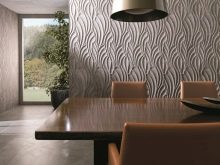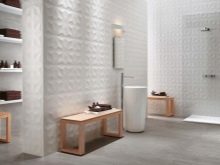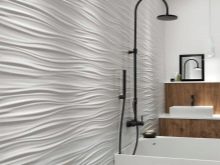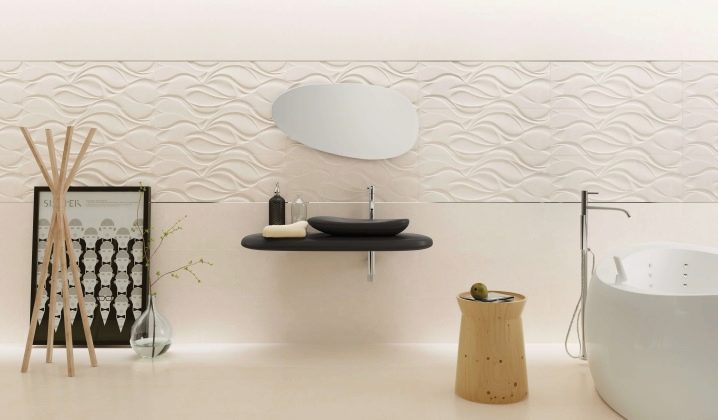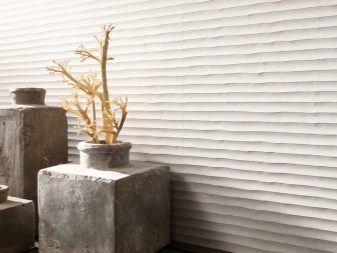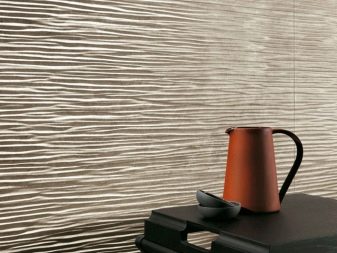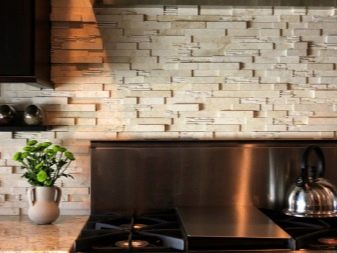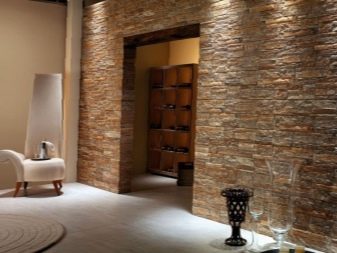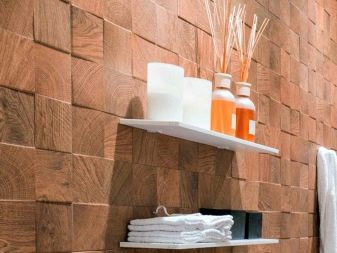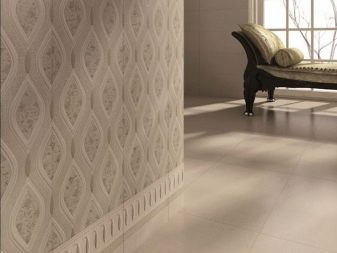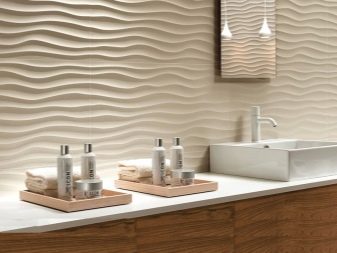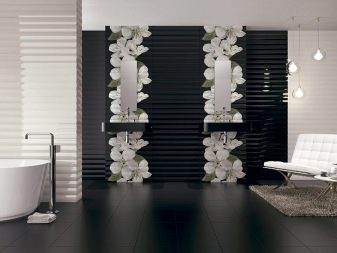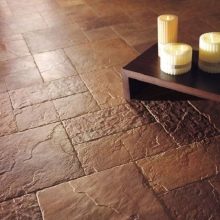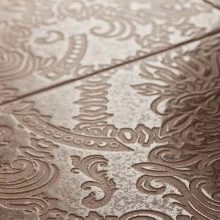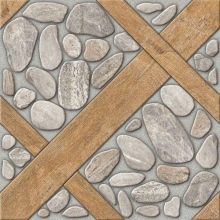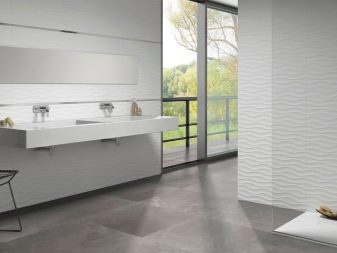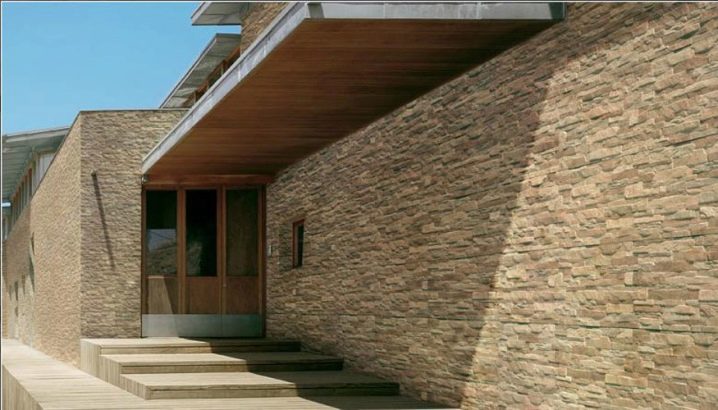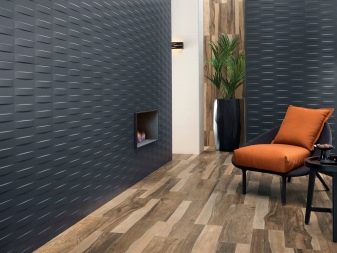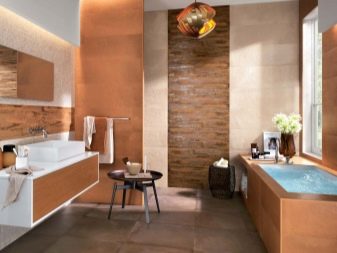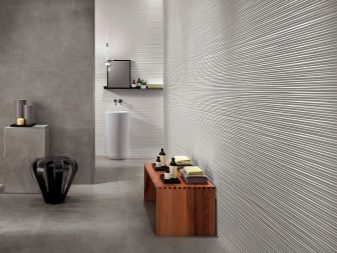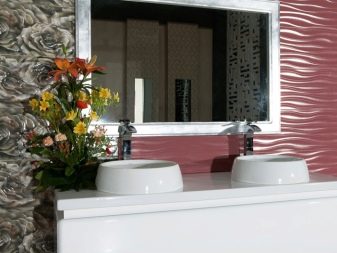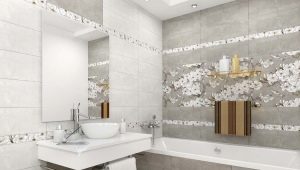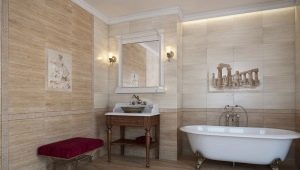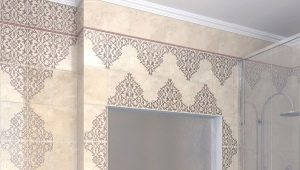Relief tiles: features and benefits
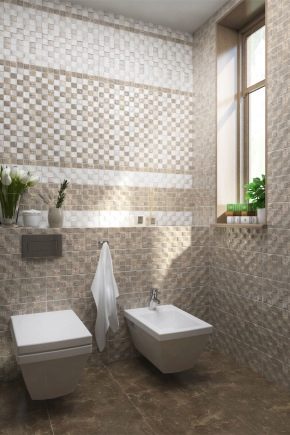
Ceramic tile is one of the most popular materials for interior and exterior decoration. It is durable, durable and beautiful, which is the main criteria when choosing a buyer. Currently, manufacturers offer tiles in any style, color and size.
One of the innovations in recent years has become a tile that imitates various textures. This innovation has greatly expanded its scope. Previously, the only rooms for laying tiles were a bathroom and a kitchen, now it is decorated with facades of buildings, verandas, floors, walls in living rooms and public places.
Manufacturing methods
Relief tile suggests a protruding pattern or pattern on the surface. It is made of clay in the same ways as smooth. Apply the method of cutting, pressing, casting or extruding.Considering the scale of modern production, the molding method is popular, which makes it possible to obtain identical samples for the entire batch, which facilitates styling.
Designers, to make the interior unusual and distinctive features, order products made by hand, or make them yourself with the help of small kilns. Such tile due to its uniqueness and originality is gaining popularity. There is open space for imagination, grass prints or a chaotic pattern, each tile will be unique.
Interspersing or gluing to the material of shells, crystals, stones, metal, mirrors, spangles or other products is another way to create a unique floor and wall covering.
As a rule, small factories and workshops are made to order.
Types of reliefs
The following patterns can be found in the catalog of manufacturers of ceramic products.
- Plants. Flowers and buds, grass, trees, leaves, everything that is found in the world of flora can be displayed on clay. There is a partial or complete image. It is possible to make small inserts with one beautiful flower or to lay out the whole wall with a tile with the image of a meadow,jungle or a collage of plants.
- Fauna. For bathrooms, images of fish, shells, mollusks in various designs are popular. There is a tile with birds, wild and domestic animals in the form of panels or small tiles.
- A natural stone. Marble - imitation of this stone is found in the collections of the most famous companies from Spain, Germany, France. Tile with such an invoice acts as a base and looks perfect in any room. The texture of granite, slate, onyx, quartz and other stones is not only recreated, but also used in its present form.
- Brick. A popular type of relief suitable for discreet interiors in the style of a loft or minimalism. Ideal replacement for natural material.
- Geometric shapes and lines. Horizontal and vertical, straight and wavy lines, various shapes in different quantities and combinations.
- Antique patterns. Imitation of drawings of ancient civilizations to create an interior in an unusual style.
- Folk ornaments. Drawings in the form of ornaments of various countries and peoples, for example, Gzhel, Khokhloma, Moors, Moroccan patterns and much more.
- The texture of fabric, leather, wood. Imitation satin, silk and other material suitable for covering a large volume of walls. Tile with wood relief - a replacement for laminate or parquet in any room. “Wooden” porcelain is used for paths, facades and other exterior finishes.
- Stained glass windows.
- 3D effect. Unusual tile that creates visual effects thanks to the printed pattern. It imitates everything from soap bubbles to optical illusions.
- Fretwork For the decoration of the bathroom, for example, in the Baroque style, create ceramic curbs, columns and their bases.
Where and how to use?
Despite the large scope, as a rule, relief tiles are used in combination with a smooth one or a combination of a more convex pattern with a less noticeable one. Volumetric textures can be used to separate and highlight different zones in the room without changing the basic color of the interior.
In bathrooms, relief tiles are often laid in the form of horizontal or vertical stripes. In a larger space, the decoration of the whole wall looks unusual.
The most popular way - the decor in the form of inserts, focusing on an unusual finishing material.
Use a relief tile not only for walls, but also for a floor.Its uneven surface is great as a floor covering in the bathroom, stairs, pools or in public places, because, first of all, it has anti-slip effect.
Many manufacturers produce special models in the framework of collections for finishing steps or tracks with a linear pattern in the form of recesses. Tile with imitation of marble is suitable for the floor in shops or restaurants, its roughness does not allow shoes or furniture to slip.
It should be noted that such material is used not only for beauty, but also for use. In residential premises or in specialized institutions, relief structures are necessary for a better orientation in space of people with visual impairments.
Laying tiles interspersed with stones or shells on the floor is an excellent foot massage. Putting this in the bathroom, you can combine business with pleasure.
To finish the facades of buildings used porcelain. It is stronger than ordinary ceramic tiles, fireproof, moisture resistant and more dense. Relief options of such finishing will allow to replace an expensive natural stone, a brick or a tree.
Advantages and disadvantages
The advantages of using embossed walls are:
- Beauty and aesthetics. Undoubtedly, this tile will make any room unusual, comfortable, bright, pleasant to the eye. Different visual effects, the play of light and shadow will give the opportunity to see the room every time in a new way. With its help, you can visually expand a small room or make higher ceilings.
- Strength. Floor or wall covering will last longer, especially in places with high humidity.
- Diversity. A large number of textures, among which you can find an option for any design idea. In the absence of the necessary in the collections of famous brands, the desired can be made to order.
There are also disadvantages. In the first place - this is the price. The cost of a tile with a relief structure is significantly different from the base in any collection. The more elaborate and more complex the drawing, the more it costs. This should not be forgotten when choosing a design room and calculating the cost of the project.
The second negative is the appearance of the surface itself. Due to the grooves and bumps such walls and floors are more difficult to clean. Problems may arise when cutting tiles and grouting. All work must be done accurately and accurately so as not to spoil the look of the pattern.
See the following video for tips on choosing and laying relief tile.
